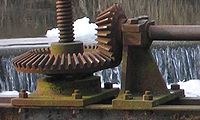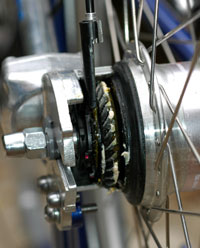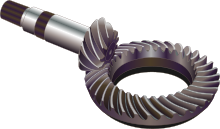Bevel gear: Difference between revisions
m Reverted edits by Spinninghead80 to last revision by 12.5.10.153 (HG) |
No edit summary |
||
| Line 1: | Line 1: | ||
the bevel gear are two gears that are on top of eachother like a mommy and daddy are conically shaped. |
|||
Bevel gears are most often mounted on shafts that are 90 degrees apart, but can be designed to work at other angles as well. The pitch surface of bevel gears is a [[cone (geometry)|cone]]. |
Bevel gears are most often mounted on shafts that are 90 degrees apart, but can be designed to work at other angles as well. The pitch surface of bevel gears is a [[cone (geometry)|cone]]. |
||
[[Image:Crown gears on roller-door at Ngcobo.jpg |thumb|200px|Bevel gear on roller shutter door.]] |
[[Image:Crown gears on roller-door at Ngcobo.jpg |thumb|200px|Bevel gear on roller shutter door.]] |
||
Revision as of 16:38, 11 September 2009
the bevel gear are two gears that are on top of eachother like a mommy and daddy are conically shaped. Bevel gears are most often mounted on shafts that are 90 degrees apart, but can be designed to work at other angles as well. The pitch surface of bevel gears is a cone.





Introduction
Two important concepts in gearing are pitch surface and pitch angle. The pitch surface of a gear is the imaginary toothless surface that you would have by averaging out the peaks and valleys of the individual teeth. The pitch surface of an ordinary gear is the shape of a cylinder. The pitch angle of a gear is the angle between the face of the pitch surface and the axis.
The most familiar kinds of bevel gears have pitch angles of less than 90 degrees and therefore are cone-shaped. This type of bevel gear is called external because the gear teeth point outward. The pitch surfaces of meshed external bevel gears are coaxial with the gear shafts; the apexes of the two surfaces are at the point of intersection of the shaft axes.
Bevel gears that have pitch angles of greater than ninety degrees have teeth that point inward and are called internal bevel gears.
Bevel gears that have pitch angles of exactly 90 degrees have teeth that point outward parallel with the axis and resemble the points on a crown. That's why this type of bevel gear is called a crown gear.
Miter gears are mating bevel gears with equal numbers of teeth and with axes at right angles.
Skew bevel gears are those for which the corresponding crown gear has teeth that are straight and oblique.
Teeth
There are two issues regarding tooth shape. One is the cross-sectional profile of the individual tooth. The other is the line or curve on which the tooth is set on the face of the gear: in other words the line or curve along which the cross-sectional profile is projected to form the actual three-dimensional shape of the tooth. The primary effect of both the cross-sectional profile and the tooth line or curve is on the smoothness of operation of the gears. Some result in a smoother gear action than others.
Tooth line
The teeth on bevel gears can be straight, spiral or "zero".
Straight tooth lines
In straight bevel gears the teeth are straight and parallel to the generators of the cone. This is the simplest form of bevel gear. It resembles a spur gear, only conical rather than cylindrical. The gears in the floodgate picture are straight bevel gears. In straight, when each tooth engages it impacts the corresponding tooth and simply curving the gear teeth can solve the problem.
Spiral tooth lines
Spiral bevel gears have their teeth formed along spiral lines. They are somewhat analogous to cylindrical type helical gears in that the teeth are angled; however with spiral gears the teeth are also curved.
The advantage of the spiral tooth over the straight tooth is that they engage more gradually. The contact between the teeth starts at one end of the gear and then spreads across the whole tooth. This results in a less abrupt transfer of force when a new pair of teeth come in to play. With straight bevel gears, the abrupt tooth engagement causes noise, especially at high speeds, and impact stress on the teeth which makes them unable to take heavy loads at high speeds without breaking. For these reasons straight bevel gears are generally limited to use at linear speeds less than 1000 feet/min; or, for small gears, under 1000 r.p.m.[1]
Zero tooth lines
Zero bevel gears are an intermediate type between straight and spiral bevel gears. Their teeth are curved, but not angled.
Applications
The bevel gear has many diverse applications such as locomotives, marine applications, automobiles, printing presses, cooling towers, power plants, steel plants, railway track inspection machines, etc.
For examples, see the following articles on:
- Bevel gears are used in differential drives, which can transmit power to two axles spinning at different speeds, such as those on a cornering automobile.
- Bevel gears are used as the main mechanism for a hand drill. As the handle of the drill is turned in a vertical direction, the bevel gears change the rotation of the chuck to a horizontal rotation. The bevel gears in a hand drill have the added advantage of increasing the speed of rotation of the chuck and this makes it possible to drill a range of materials.
- The gears in a bevel gear planer permit minor adjustment during assembly and allow for some displacement due to deflection under operating loads without concentrating the load on the end of the tooth.
- Spiral bevel gears are important components on rotorcraft drive systems. These components are required to operate at high speeds, high loads, and for a large number of load cycles. In this application, spiral bevel gears are used to redirect the shaft from the horizontal gas turbine engine to the vertical rotor.

Advantages
- This gear makes it possible to change the operating angle
- Differing of the number of teeth (effectively diameter) on each wheel allows mechanical advantage to be changed. By increasing or decreasing the ratio of teeth between the drive and driven wheels one may change the ratio of rotations between the two, meaning that the rotational drive and torque of the second wheel can be changed in relation to the first, with speed increasing and torque decreasing, or speed decreasing and torque increasing.
Disadvantages
- One wheel of such gear is designed to work with its complementary wheel and no other.
- Must be precisely mounted.
- The axes must be capable of supporting significant forces.
See also
References
- ^ Doughty and Vallance, Design of Machine Members.
